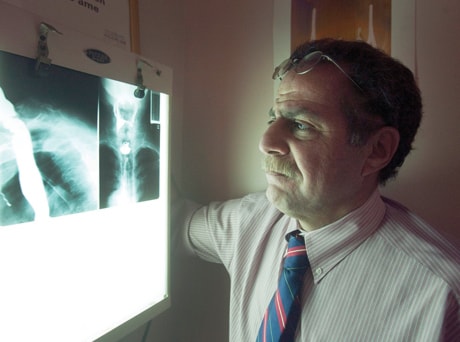MONTREAL — Sandra Hudgin didn’t have any clue she had thyroid cancer until the day she was goofing around with her frisky basset hound.
“His head bumped me in the neck and for some reason, I was really uncomfortable,” she said of the day about 20 years ago.
“It didn’t go away, the discomfort, so I went in and started looking in the mirror.” The registered nurse found a lump, which was later confirmed by her doctor.
He ordered an ultrasound and then a needle biopsy. Two more biopsies followed until the diagnosis was confirmed as thyroid cancer, a disease that is being detected more frequently than all other cancers in recent years.
The 2010 Canadian Cancer Statistics Report prepared by Statistics Canada says it has gone up 9.5 per cent per year in females and 6.8 per cent per year in males since 1998.
Similar increases had also been seen in Europe and some regions of the United States.
About 5,200 Canadians — 4,100 women and 1,050 men — will be diagnosed with thyroid cancer this year, the report said.
The most recent actual data on mortality says 146 Canadians died from the disease in 2005.
Hudgin underwent surgery, the preferred treatment, to remove her thyroid and now takes a hormone replacement drug to do the job of the gland, which has been described as the body’s “thermostat.”
“I found out by absolute fluke,” Hudgin says of her cancer in a telephone interview from her home in St. George, Ont.
“Sometimes lifestyle comes into play with some disorders but I’ve always been very athletic, I’ve always been an excellent eater, I’m not a junk food eater. I’m probably the last person in the world you’d expect to get cancer or get sick but that’s just the way that disease can work sometimes.”
These days, she says, she feels fine and has an active, normal life.
Dr. Roger Tabah, a surgical oncologist at the McGill University Health Centre in Montreal, says research is still being done into thyroid cancer, but causes include heredity and low doses of ionizing radiation.
“In the 1940s and 1950s, radiation was kind of the soup de jour and a lot of dermatology offices had X-ray machines,” he said, noting that acne and tonsillitis were being treated with radiation.
He even recalled a shoe store chain that had an X-ray type of machine which was used as a sales gimmick. It was used to show parents how well shoes would fit their children.
Reports started coming out in the 1960s suggesting more caution should be used with radiation.
“They noticed an increased incidence of well-differentiated thyroid cancer, the papillary and follicular varieties,” Tabah said. Those two are the most common.
Increased use of ultrasounds, magnetic resonance imaging, CT scans and needle biopsies is being credited among the reasons more cases are being detected.
“Nowadays we’re doing ultrasound, we’re picking up very small lesions, we’re able to characterize them,” Tabah said. “Maybe we’re picking up small cancers that may in the past have not bothered patients.”
He said the lumps would usually show up in the main part of the neck where the butterfly-shaped thyroid lives or sometimes on the side.
Other symptoms, depending on the size of the tumour, could include difficulty breathing or swallowing. If the lump is impinging on the nerves that control the vocal cords, the voice could be breathy and weak.
Tabah acknowledged that thyroid cancer can be tricky to diagnose because lumps in the thyroid are relatively common.
Doctors look at the lumps from a variety of perspectives, which can be a focus on the dominant nodule, its growth rate or features on the ultrasound associated with malignancy.
“It may even just boil down to how it feels on your fingertips — you don’t really like the feel of it,” Tabah said.
Although thyroid cancer is usually described as the best type of cancer to get because of its slow growth and high recovery rate, both Tabah and Hudgin insisted that early detection is best.
Both said self-examination is a good prevention strategy, simply by tilting the head back, looking in the mirror and probing the neck to see if anything looks or feels unusual.
If something is noticed, it’s better to be safe than sorry.
“A lump anywhere in the body that is new or unexplained should be brought to your physician’s attention, period,” said Tabah.
Hudgin said blood tests are also a big factor in determining what is wrong.
“There are a number of people who have gone on antidepressants and their depression would have been treated by taking a thyroid hormone pill,” she said. “Same applies with anxiety, which is often the case with the hyper (thyroid).”
While it is becoming more common, there is a lack of awareness in the general public about thyroid cancer that can leave some patients feeling they’ve been set adrift.
Hudgin said people need to know right off the bat what resources are available — and which ones are credible. “It would be nice to see more come right out of the doctor’s office,” Hudgin said. “That’s where people need to be advised on what are the resources, whether it be cancer of the thyroid or something else.”
